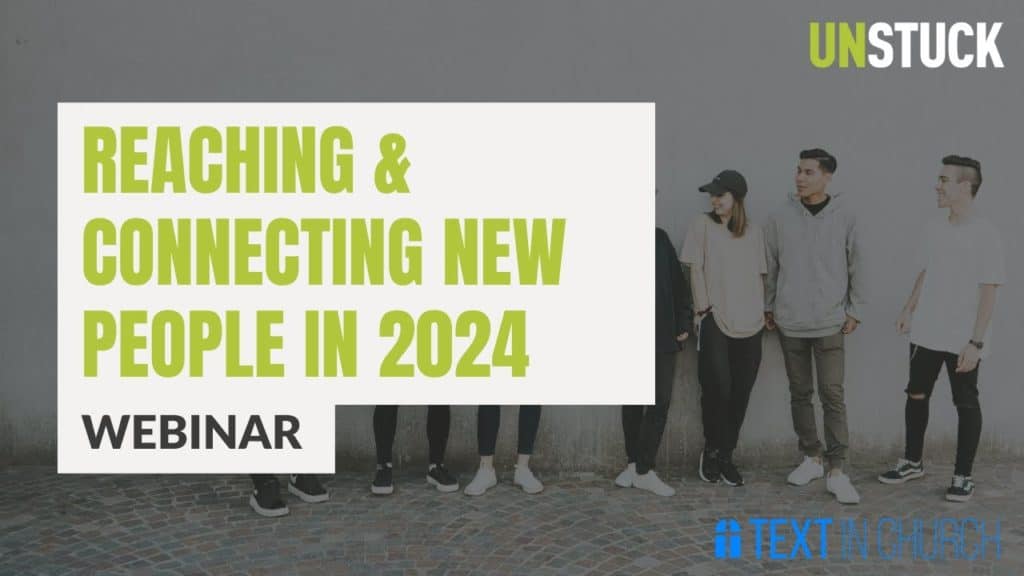How to Build a Hybrid Church (Part 1)
If you enjoy this episode, subscribe on your device for more:
iTunes RSS Google Play Stitcher Spotify
Congratulations, you did it! You survived 2020. It’s hard to believe but it felt like we were cramming as many disruptions as we could into one year, but you made it! You’re here with us today. So congratulations. It seems like we should all get a participation trophy for getting through that year.
As you know, the multiple disruptions we faced have caused churches to shift their ministry focus and strategies, and rightly so. We were all in reactive mode for much of 2020, but now it’s 2021. And those stop-gap strategies that churches used to get through the last year are not going to be the same things that help us experience long-term health and success in our ministry.
Because of that, we’re kicking off a new series around How to Build a Hybrid Church.
We’ve heard from a lot of church leaders like you asking questions like…
- What does it look like to build a hybrid church?
- How do we restructure our church staff?
- How do we approach financial health? (Because a number of churches are experiencing a decline in giving.)
- And lastly, how do we plan for the future in uncertain times?
Join me today for an introduction to practical strategies for building a hybrid church:
- What post-covid churches will look like
- Why digital ministry strategy is overwhelming and what to do about it
- How hybrid churches will reach people
Leader Conversation Guide
Want to take this conversation back to a staff or senior leadership team meeting?
Our Show Notes subscribers get a PDF download that recaps the episode content and includes a discussion guide you can print out and use at an upcoming meeting.
Opt-in here and get the Leader Conversation Guide for this episode, as well as access to the archive.
Let Us Know on Social Media
We use #unstuckchurch on Twitter, and we start a real-time conversation each Wednesday morning when the episode drops. We’d really love to hear from you during this time:
- How can we be praying for you as a lead and your church?
- What stories can you share of ways churches are responding well during this crisis and focusing on opportunities instead of loss?
You can follow me @tonymorganlive and The Unstuck Group @unstuckgroup. If Facebook is where you spend your time, I’m there, too.
Links & Resources from the Episode
- Designing Your Digital Ministry Strategy
- How to Build a Hybrid Church – An Unstuck Masterclass
- How to Measure Online Disciple Making
- How to Pick Your Strategic Planning Team
Write a Review—It Helps!
Particularly on iTunes, your ratings and reviews really do help more pastors discover the podcast content I’m creating here. Would you take a minute to share your thoughts? Just open the the podcast on iTunes on your phone or computer, click Ratings & Reviews, and leave your opinion.
Transcript
Sean (00:02):
Welcome to The Unstuck Church Podcast, where each week we’re exploring what it means to be an unstuck church. As each week passes, it’s beginning to seem like there’s a new reality. Many of us are hoping for more face-to-face interaction soon, but there’s no doubt that our new digital habits aren’t going away. So how will your church respond? This week, Tony and Amy begin a four-part series on the new realities for churches as they balance digital and in-person ministry. Before you listen today, if you haven’t yet, make sure you stop and subscribe to get the show notes. Every week, you’ll get one email with resources to go along with that week’s episode, including our leader conversation guide, access to her podcast resource archive, and some bonus resources that you’re not going to find anywhere else. Just go to theunstuckgroup.com/podcast and subscribe. Now let’s join Tony and Amy for week one of our new series.
Amy (00:55):
Well, welcome back from the holidays and welcome, Tony, to 2021.
Tony (01:00):
Yes, finally.
Amy (01:01):
I know, I’m excited for the new year, and I’m excited about actually this new podcast series too. Tony, would you give us an overview of what we’ll be discussing for the next several weeks?
Tony (01:11):
Of course, but yeah, first of all, congratulations. You did, you survived 2020. It’s it’s hard to believe that we tried to cram as many disruptions as we could into one year, but that’s what happened, and you’re here with us today, so congratulations. It feels like, I don’t know, Amy, do they hand out a pandemic participation trophies? It feels like we all should get one this year.
Amy (01:35):
I think we all should get one. Anyone who survived 2020 and lived through all that.
Tony (01:41):
Well, needless to say, the multiple disruptions we faced in the last year have caused churches to shift their ministry strategies and focus, and rightly so. I mean, we were all pretty much in reactive mode for much of 2020, but now it’s 2021. And those stop-gap strategies that churches have used to get through the last year are not going to be the same things that help us experience long-term health and success in our ministry. And because of that, we’ve heard from a lot of church leaders, like you, asking questions around four key things in recent weeks. What does it look like to build a hybrid church? And that’s where we’re going to focus today’s conversation, by the way. How do we restructure staff and make sure our staff is healthy coming out of what we experienced last year? Many churches are asking questions about financial health now because a number of churches are experiencing decline in giving. And then finally, in this series, we want to talk about planning for the future in times of uncertainty, because that, again, is a common question that we’re hearing. So we’re going to hit each of those four topics over these next four weeks in this series. And then, I wanted to let you know today for the very first time about what’s going to happen on February 4th. I want to invite you on that day to join us for our first Masterclass of 2021. We’re calling the Masterclass, “You Survived 2020. Now what?” Do you like that, Amy?
Amy (03:17):
Yeah, that’s very clever. Very creative.
Tony (03:18):
Yeah. I came up with that. I’m pretty proud of that one.
Amy (03:22):
We’ll give the participation trophies at the Masterclass, how does that sound?
Tony (03:25):
There you go. Okay. So we’re going to do a deeper dive on those four topics that I just mentioned during the Masterclass. And then we’re also going to talk with some folks who are engaging these challenges in the trenches to hear what they’re learning, and I’ll share more at the end of today’s conversation, but your team can register for that Masterclass on February 4th at theunstuckgroup.com/masterclass.
Amy (03:48):
Yeah. Well, thanks for sharing that overview. Let’s jump right into that first topic. It’s no surprise to me that churches are still asking questions about what it means to be a hybrid church going forward. So maybe start, Tony, by explaining what we mean by a hybrid church.
Tony (04:03):
Yeah. So, basically when we talk about hybrid church, we’re talking about a combination of both physical and digital ministry environments and strategies to accomplish the church’s mission and vision. So as an example, during COVID, digital strategies completely replaced physical gatherings for a season and even some churches, that’s still the case. And that was out of necessity. I mean, we were forced into that. Post-COVID, however, it’s not about replacing physical gatherings. Instead, when we talk about hybrid church, we’re talking about complementing our physical gatherings with digital strategies, and the good news about where we’re heading into the future is it’s going to be optional. No one’s going to be forcing you to become a hybrid church, but I think we’re going to find that more and more churches are going to move in that direction to embrace these hybrid strategies to fulfill the mission that God’s called their church to. And with that, I think these are going to be exciting times ahead because rather than being forced to be a 100% digital because of the lockdowns, in the post-COVID world, churches are going to begin to experiment more and learn what works in physical gatherings. But that may not always work with digital strategies and vice versa. In other words, hybrid churches won’t use the same strategies in physical and in digital environments. Hybrid churches will leverage distinctive strategies in those two environments to accomplish the same mission.
Amy (05:41):
Yeah, no doubt. Part of becoming a hybrid church that’s leading to the questions we’re hearing isn’t because the physical gatherings, it’s because of the digital strategy, right? Why do you think digital strategy is so overwhelming for church leaders?
Tony (05:56):
Amy, that’s a good question. And, you know, I think for too long, we’ve viewed digital strategy as solely a means for communications and for promoting ministry rather than a means of engaging ministry with people to help them take their next steps toward Jesus. I’m reminded from my days back at Granger Community Church, and goodness, I’m getting old. This is like 20 years ago now, I think. But we were in the middle of a building campaign, and the slogan for that particular building campaign at Granger Community Church was, “it’s not about buildings, it’s about people.” And I kind of want to pull that slogan back into current times to say this. “It’s not about websites and streaming technology and YouTube channels and social media and other digital platforms. It’s about people.” And the fact is most of us can’t design and construct buildings without experts involved. Instead, we design ministry strategies and then we hire the experts to help us design and construct buildings. And likewise, I don’t think most of us can design and build websites or streaming solutions. We need to stick to designing ministry strategies and then hire the experts to help us design and construct the digital solution. So here’s the key thought here, and this might help us get beyond some of the, maybe, challenge that we feel when it comes to digital ministry strategies. We need to remember that both buildings and digital solutions are about engaging with people. It’s about people, helping people take their next steps toward Jesus. We don’t need to use buildings to promote ministry. We use buildings to engage ministry, and likewise, we should stop using digital platforms to promote ministry. Instead, we should use digital platforms to engage ministry. It’s about people, and you know how to do ministry. You know how to engage with people, you know how to help people take their next steps toward Christ. We need to look at how do we engage with people, help them in their spiritual journey, rather than how do we promote what’s happening at our churches?
Amy (08:15):
You know, along those same lines, Tony, we’ve talked a lot about how hybrid churches need to engage with people in all phases of their spiritual journey. Will you unpack that thought for us?
Tony (08:25):
Yeah. So, several times in the last number of months, we’ve talked about kind of these five stages of anyone’s spiritual journey. And this is just a reflection, Amy, of what I acknowledge happened in my spiritual journey, moving from a point where first, I was not interested in the faith. Secondly, becoming spiritually curious. Thirdly, accepting Christ, becoming a believer, a Jesus follower. Number four, being discipled, and then five, becoming a disciple-maker. So there’s these five stages in a spiritual journey, and what you and I are seeing as we engage with churches, even in recent months, most churches are only focused on ministry for people who are at steps three and four in that spiritual journey. And so I think how this conversation relates to what we’re talking about today related to hybrid churches is this. Hybrid churches, going forward, are going to offer both physical and digital expressions to reach people who are at steps one and two. They’re not interested in the faith or they’re spiritually curious. Now here’s my sense though. My sense is this, that digital expressions are super critical for engaging people who are early in their spiritual journey, but that doesn’t mean we should never experiment with physical gatherings for folks that are in those early steps as well. You know, as an example, even pre-COVID, we were seeing many people were watching services online before they attended a service at a church. And so, think about people who are spiritually curious. They’re checking out your church, they’re considering coming to your church and actually engaging in a physical expression of your ministry. Many times, people, even in those early steps in their spiritual journey, were starting with a digital expression of what the church was offering. Also, both physical and digital expressions to encourage next steps for believers and people who are being discipled. So thinking about people that are steps three and four. It’s going to be important as a hybrid church to have both expressions there as well. But my sense is that physical expressions are going to be super critical for engaging people who are further along in their spiritual journey. But that doesn’t mean that we should never experiment with digital environments for those folks as well. And as an example, I can’t recall this was, I think this was a conversation, Amy, you were having with a pastor not too long ago, where the pastor was kind of shocked to hear that people were actually engaging every message in his recent teaching series during the pandemic, because it was the first time they actually had easy access to all the messages online. So it’s a good example of, again, now we’re talking about people further along in their spiritual journey and yes, primarily that may happen through physical expressions, but the digital strategies can certainly compliment what we’re hoping and encouraging people will experience as we offer next steps on a spiritual journey.
Amy (11:54):
Yeah. Maybe I can just add this for our listeners. If you’re listening today and you’re looking for more specifics on designing a digital engagement strategy to help people in all of those five phases that Tony just talked about, you’ll want to go back and watch our Masterclass content from last fall, because we presented a full day of content on that very topic. And by the way, that previous Masterclass and all our content are available through our coaching subscriptions, which started only $49 a month. And you can just learn more about that, how to access those resources at theunstuckgroup.com/coaching. So Tony, any final thoughts before we wrap today’s conversation?
Tony (12:31):
Yeah. Amy, thank you for mentioning that Masterclass we did back in the fall on building a digital engagement strategy. You know, if I remember correctly, we had close to 800 people participate in that one-day experience. And the feedback we received was just phenomenal. And this upcoming Masterclass that we have planned for February 4th, it’s going to be just as strong. You and I have been working on the content for that day already. And I’m super excited about what we’re going to be talking about and also the special guests that will be joining us. And again, the focus of that day will be around these four questions that church leaders are asking related to what’s next for the church in 2021? So let me share this additional thought. I get invited by pastors all the time who want me to come speak at their staff leadership gatherings or retreats. I just got another request just this last week for that. And I think it’s mainly because pastors don’t want to develop all that content themselves to deliver to their team. And I get it. I don’t have that time to prepare sermons every week either. So I get the trade off there, but because my time is limited and travel expenses are usually involved, that can be fairly expensive for most churches. So this is your chance to offer that type of a team retreat experience at the beginning of our new year for a very low price. So make plans today to sign up with your leadership team and spend a day with Amy and me on February 4th. And we’ll take care of developing that full day of content. You just show up with your team, and this will be a great way for you and your team to break away from day-to-day ministry and begin to reflect together on what God has for your church in the new year.
Sean (14:14):
Well, thanks for joining us on this week’s podcast. As Tony mentioned, don’t forget to sign up now to be a part of our upcoming Masterclass focused on the new realities of ministry in 2021. You can learn more and sign up by going to theunstuckgroup.com/masterclass. If you like what you’re hearing on the podcast, we would love your help in getting the content out. You can help us by subscribing on your favorite podcasting platform, giving us a review and telling somebody else about the podcast. Next week, we’re back with another brand new episode. Until then, have a great week.






